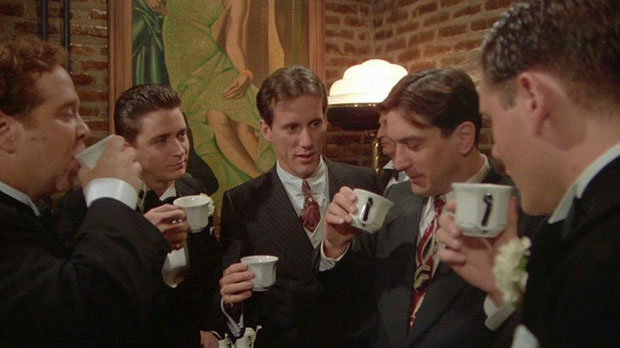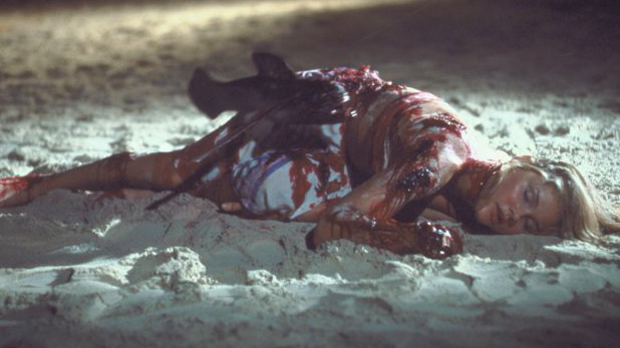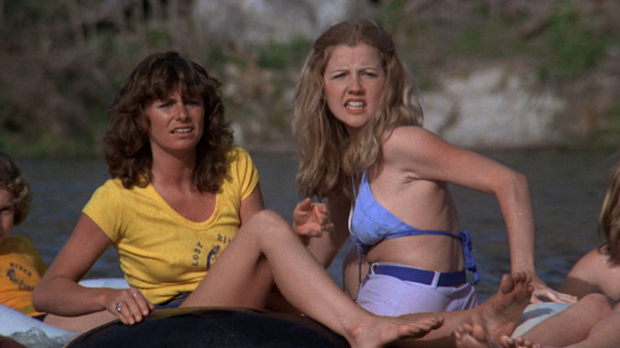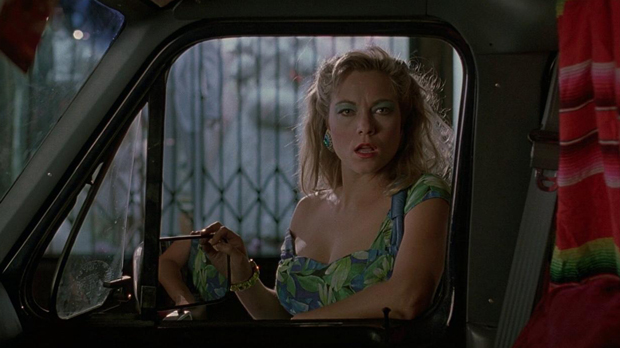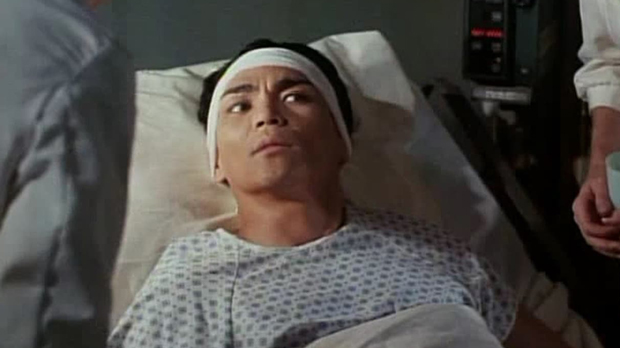 Once Upon a Time in America (1984) The Ladd Company/Drama RT: 229 minutes Rated R (strong violence including rape, sexual content, language, some drug use) Director: Sergio Leone Screenplay: Leonardo Benvenuti, Piero De Bernardi, Enrico Medioli, Franco Arcalli, Franco Ferrini and Sergio Leone Music: Ennio Morricone Cinematography: Tonino Delli Colli Release date: June 1, 1984 (US) Cast: Robert De Niro, James Woods, Elizabeth McGovern, Joe Pesci, Burt Young, Tuesday Weld, Treat Williams, Danny Aiello, Richard Bright, James Hayden, William Forsythe, Darlanne Fluegel, Larry Rapp, Richard Foronji, Scott Tiler, Rusty Jacobs, Brian Bloom, Adrian Curran, Noah Moazezi, Mike Monetti, Jennifer Connelly, James Russo, Robert Harper, Dutch Miller, Gerard Murphy, Amy Ryder, Julie Cohen, Arnon Milchan, Marcia Jean Kurtz, Estelle Harris, Joey Faye, Olga Karlatos, Frank Gio, Ray Dittrich, Mario Brega, Chuck Low, Francesca Leone. Box Office: $5.3M (US)
Once Upon a Time in America (1984) The Ladd Company/Drama RT: 229 minutes Rated R (strong violence including rape, sexual content, language, some drug use) Director: Sergio Leone Screenplay: Leonardo Benvenuti, Piero De Bernardi, Enrico Medioli, Franco Arcalli, Franco Ferrini and Sergio Leone Music: Ennio Morricone Cinematography: Tonino Delli Colli Release date: June 1, 1984 (US) Cast: Robert De Niro, James Woods, Elizabeth McGovern, Joe Pesci, Burt Young, Tuesday Weld, Treat Williams, Danny Aiello, Richard Bright, James Hayden, William Forsythe, Darlanne Fluegel, Larry Rapp, Richard Foronji, Scott Tiler, Rusty Jacobs, Brian Bloom, Adrian Curran, Noah Moazezi, Mike Monetti, Jennifer Connelly, James Russo, Robert Harper, Dutch Miller, Gerard Murphy, Amy Ryder, Julie Cohen, Arnon Milchan, Marcia Jean Kurtz, Estelle Harris, Joey Faye, Olga Karlatos, Frank Gio, Ray Dittrich, Mario Brega, Chuck Low, Francesca Leone. Box Office: $5.3M (US)
Rating: ****
If murdering a movie was a felony, those that butchered Sergio Leone’s masterpiece Once Upon a Time in America prior to its US release would be serving life sentences without parole. In their infinite wisdom, the folks at the now-defunct Ladd Company decided it would be a good idea to cut the nearly four-hour gangster drama by 90 minutes and rearrange the non-chronological story into chronological order. They believed it would make it more commercially viable and clarify the plot for audiences. Instead, they turned it into an incomprehensible mess that not even Sherlock Holmes could decipher. It bombed as I expected and disappeared quickly from theaters.
By way of protest, I refused to see the shortened version of Once Upon a Time in America. It’s bad enough the studio did a total botch job on it. It’s made worse by them doing it against Leone’s wishes. It still angers me to this day. I decided to hold out until I could see it in its intended form; it was my way of showing support for the artist and his original version. Luckily, the studio wisely released the (almost) full version on video the following February. That’s when I saw it and it was excellent. I didn’t know it then, but it was trimmed by three minutes due to two rape scenes and some graphic violence. It was finally released in its entirety on DVD in ’03. Well, not exactly its entirety. Leone originally delivered a 269-minute cut of Once Upon a Time in America, but was convinced by distributors to shorten it to 229 minutes. A restored version of the 4-hour 29-minute movie is currently in the works (according to Wikipedia).
There is no easy way to explain the plot of Once Upon a Time in America with its mosaic-like narrative. It doesn’t mean I won’t try. I’ll start with the framing device set in 1968. After 35 years of self-exile, former gangster Noodles (De Niro, Raging Bull) returns to his old stomping grounds in Manhattan’s Lower East Side to confront demons from his past. All these years, he’s been carrying the guilt of betraying his friends to the police and causing their deaths. He soon learns he’s not the betrayer but the betrayed.
The events leading up to the incident that changed Noodles’ life for the worse are related through a series of flashbacks starting in 1918 when he just a young street punk who roamed the streets with his friends doing odd jobs for local crime boss Bugsy (Russo, Beverly Hills Cop). He’s in love with a girl named Deborah (Connelly in her debut), an aspiring actress and dancer who’s obviously too good for him. She tells him as much. One day, he meets Max who convinces them to start their own gang independent of Bugsy. They briefly enjoy success before their old boss murders one of the boys. Noodles kills him in retaliation and goes to prison for it.
When he gets out circa 1930, he learns his old gang- Max (Woods, Against All Odds), Cockeye (Forsythe, Extreme Prejudice) and Patsy (Hayden who died before the film’s release)- made it big in the bootlegging business while he was away. They operate out of a speakeasy owned by their childhood friend Fat Moe (Rapp). That’s not the only illegal enterprise they’re into. They also provide protection for a labor union boss (Williams, Prince of the City) who goes from idealistic to corrupt upon realizing there’s no room for an honest man in the union racket. Meanwhile, Noodles tries to rekindle his relationship with Deborah (McGovern, Ragtime) who realized her dream of becoming a dancer. Feelings haven’t changed much on either side. He’s still very much in love with her. She still thinks he’s not good enough for her.
When Prohibition ends, it effectively leaves the gang unemployed. Max comes up with the idea for a robbery that could get them all killed. In a decision not made lightly, Noodles informs on his friends to save their lives. It doesn’t work out the way he intends. His lifelong friends get killed and Noodles has to leave town to avoid three determined hitmen. That brings us full circle to ’68 where Noodles begins to piece together what really happened 35 years earlier. It’s all connected to a mysterious rich politician who invites Noodles to a party at his mansion.
It might seem like I’ve given way too much information about Once Upon a Time in America, but I assure you that’s not the case. A lot happens over the course of nearly four hours. I’m not going to sit here and list all of it. What I will say is it might or might not be a reflection of reality. This is precisely why it’s bad that the studio tampered with it. Audiences unlucky enough to witness that crime against cinema didn’t know what to make of it. When seen in its intended form, it becomes clearer what Leone is going for.
The key to understanding is in the narrative structure. Past, present and future blend together. Not everything makes sense. Flashbacks and flash-forwards occur at unexpected times. In one of the movie’s best shots, a flashback is signaled by the sudden appearance of a frisbee. Music plays an important role here too. When it first flashes forward to ’68, a forlorn rendition of “Yesterday” plays over the soundtrack. ANYWAY, what does it all mean? That’s not so simple. It could all be an opium dream experienced by De Niro’s character. Or maybe a nightmare. Or it could simply be his memory made hazy by the passage of time. Leone’s exquisite story construction of Once Upon a Time in America leaves it open to interpretation.
De Niro delivers one of his finest performances as Noodles, a complex individual haunted by a past that might not be as he remembers it, if he remembers it at all. As always, he wears his aging makeup quite well. He isn’t afraid to get his hands dirty either. Noodles isn’t a particularly decent person. He’s pretty unlikable at times. After Deborah turns down his marriage proposal in favor of her career, he rapes her in the back of a chauffeur-driven car. This is more guilt he carries with him if it indeed happened at all. Woods is at his intense best as Max whose mental instability is confirmed by his violent reaction to Noodles calling him “crazy”. He’s the electrical current that gives Once Upon a Time in America a huge jolt of power. The powerhouse cast includes Joe Pesci (Goodfellas) and Burt Young (Rocky I-VI) as a couple of Detroit mobsters who hire the guys for a job, Tuesday Weld (Thief) as the inside girl who becomes Max’s girlfriend and Danny Aiello (Do the Right Thing) as a police chief determined to break the workers’ strike only to be brought to his knees by Noodles and the gang. Richard Bright (The Godfather I-III) and Darlanne Fluegel (To Live and Die in L.A.) show up in brief roles. Young Connelly shows tremendous promise in her debut.
On an artistic level, Once Upon a Time in America scores an A+++. It’s not just a movie; it’s a work of art. It’s a perfect example of the poetry of cinema. Not only is it Sergio Leone’s final film, it’s his finest film. It’s a great companion piece to his 1968 western Once Upon a Time in the West. I love his style. He has an eye for detail. He recreates each time period with complete authenticity with regards to clothing, cars, interior décor and everything else. The score by the wonderful Ennio Morricone is simply beautiful. The cinematography by Tonino Delli Colli is gorgeous. Leone couldn’t have done what he does with Once Upon a Time in America without the help of editor Nino Baragli. It’s that rare film that’s as beautiful as it is brilliant.
Once Upon a Time in America is one of the greatest gangster dramas of all times. It’s marvelous in its original form. It’s long, violent, complex, compelling and consistently watchable. It doesn’t feel like four hours at all. I never grew bored or restless. It grabs you and pulls you right into a world that possibly exists only in an opium-induced hallucination. I can’t think of a single negative thing to say about it. It’s perfect.
